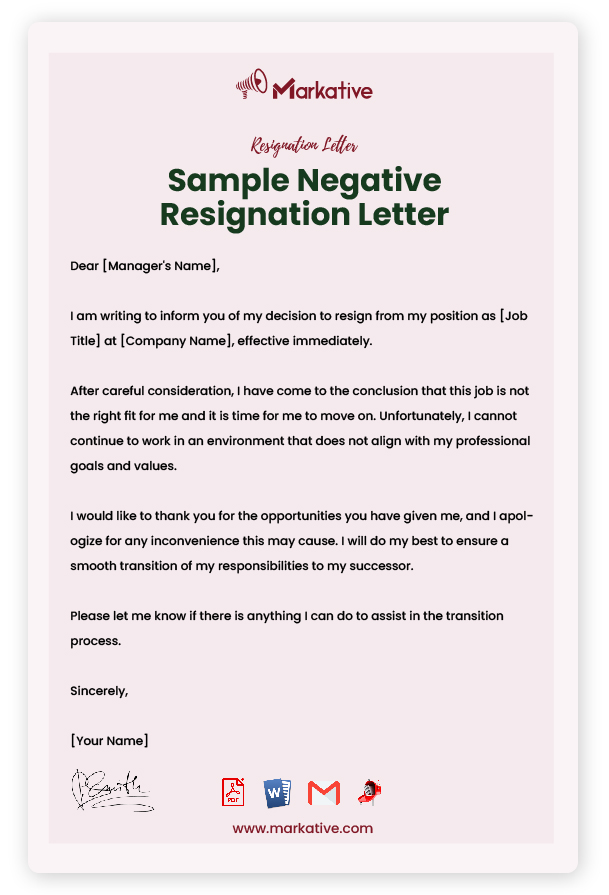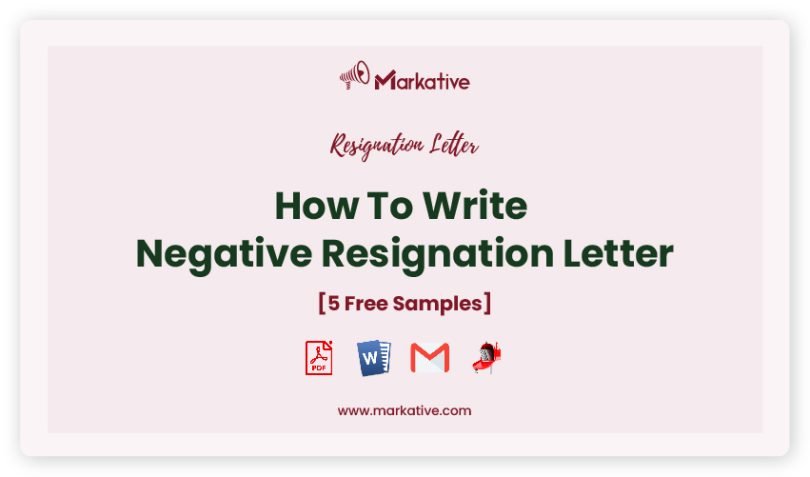Resignation is a crucial aspect of any professional’s career, but it is often overlooked or not given the attention it deserves. It is an opportunity for employees to exit their current job with grace and leave a positive impression on their colleagues and employers. A well-crafted resignation letter can help ensure a smooth transition and maintain positive relationships with the company and its employees. However, not all resignations are created equal, and a negative resignation letter can leave a lasting negative impact on a person’s reputation and career prospects.
A good resignation letter not only conveys the employee’s intention to leave but also expresses gratitude for the opportunities and experiences gained during their time with the company. It is essential to maintain a positive tone and avoid negative comments or criticism, as this can damage professional relationships and burn bridges. A well-written resignation letter can also serve as a tool for networking and future job opportunities, as it showcases the employee’s professionalism and communication skills.
Unfortunately, not all resignations are amicable, and sometimes employees may feel compelled to write a negative resignation letter due to a range of factors, such as workplace conflict or unfair treatment. However, a negative resignation letter can have significant consequences, including damaging the employee’s reputation and limiting their career prospects. In this article, we will explore the importance of resignation and how a well-crafted resignation letter can leave a lasting positive impact on your career. We will also discuss the pitfalls of a negative Negative Resignation Letter and provide tips on how to handle difficult situations professionally.
How To Write Appealing Negative Resignation Letter?
Writing a negative resignation letter can be a daunting task, especially when you have to convey unpleasant news to your employer. However, with the right approach, you can still maintain a professional tone and leave a positive impression.
Five Steps to Write an Appealing Negative Resignation Letter:
- Keep it concise and to the point: Start your letter with a clear and straightforward statement of your intention to resign. Explain your reasons for leaving briefly and avoid going into too much detail.
Example: “I regret to inform you that I am resigning from my position as Sales Manager, effective two weeks from today. This decision was not an easy one, but I have accepted a new opportunity that aligns with my career goals.”
- Express gratitude: Even if you’re leaving on a negative note, it’s important to express gratitude for the opportunities you were given and the experiences you gained while working for the company.
Example: “I want to thank you for the opportunities I have had while working here. I am grateful for the support and guidance I have received from my colleagues, and I will cherish the experiences I gained while working with this team.”
- Be professional and avoid negativity: It’s crucial to maintain a professional tone throughout the letter and avoid any negative comments or criticism. Focus on your own reasons for leaving rather than any shortcomings of the company or your colleagues.
Example: “I have decided to move on to pursue other opportunities that better align with my career aspirations. While I have enjoyed working with this team, I believe it’s time for me to seek new challenges.”
- Offer to assist with the transition: To leave a positive impression and maintain professional relationships, offer to assist with the transition process and ensure a smooth handover of your responsibilities.
Example: “I am committed to ensuring a smooth transition and will do everything I can to assist with the transfer of my responsibilities to a new team member. Please let me know how I can best support the team during this period.”
- End on a positive note: End your letter on a positive note by expressing your best wishes for the company and your colleagues in the future.
Example: “I wish the company continued success, and I hope our paths cross again in the future. Thank you for the valuable experiences and memories I will take with me as I embark on this new journey.”
Conclusion: Writing a negative resignation letter may be difficult, but following these steps can help you maintain a professional and positive tone while conveying your intentions to resign. Remember to keep it brief, express gratitude, be professional, offer assistance, and end on a positive note to leave a lasting impression.

Sample Negative Resignation Letter
Dear [Manager's Name], I am writing to inform you of my decision to resign from my position as [Job Title] at [Company Name], effective immediately. After careful consideration, I have come to the conclusion that this job is not the right fit for me and it is time for me to move on. Unfortunately, I cannot continue to work in an environment that does not align with my professional goals and values. I have enjoyed working with you and the team during my time here, but I have decided that it is in my best interest to pursue other opportunities that will enable me to grow and develop my skills. I would like to thank you for the opportunities you have given me, and I apologize for any inconvenience this may cause. I will do my best to ensure a smooth transition of my responsibilities to my successor. Please let me know if there is anything I can do to assist in the transition process. Sincerely, [Your Name]
Professional Negative Resignation Letter
Dear [Employer], It is with a heavy heart that I submit my resignation as [Your Position] at [Company Name]. After careful consideration, I have concluded that it is in my best interest to resign from my position effective [Date]. I have thoroughly enjoyed my time working at [Company Name] and appreciate the opportunities and experiences that I have gained during my tenure here. However, recent circumstances have led me to make the difficult decision to resign. I regret to inform you that my decision to resign is due to the negative work environment that has developed in recent months. As an employee, I have experienced and witnessed behavior that I believe is contrary to the values and principles that [Company Name] stands for. This includes [provide specific examples of negative behavior, such as harassment, discrimination, unethical practices, etc.]. As a professional, I cannot in good conscience continue to work for a company that tolerates such behavior. Despite my attempts to address these concerns with my supervisor and HR, I have not seen any significant action taken to address these issues. I will do my best to ensure a smooth transition during my remaining time at the company. Please let me know how I can best assist in this process. Thank you for the opportunities and support that you have provided during my time at [Company Name]. I hope that the company will take the necessary steps to address these concerns and create a positive work environment for its employees. Sincerely, [Your Name]
Negative Resignation Letter with Reason
Dear [Manager's Name], I am writing to inform you of my decision to resign from my position as [Your Position] at [Company Name]. My last day of work will be [Date of Last Day]. Unfortunately, I have found that my experience working at this company has not been positive. Despite my best efforts to contribute to the team, I have encountered several obstacles that have made it difficult for me to continue working here. These issues include [briefly mention the reasons why you are resigning]. I have attempted to address these concerns with my superiors, but I feel that my efforts have been dismissed or ignored. As a result, I have no choice but to tender my resignation. I want to thank you for the opportunities that you have given me during my time here, and for the support that you have provided. Despite the issues that I have faced, I have learned a great deal from working at this company and I am grateful for the experience. Please let me know what steps I need to take to ensure a smooth transition during this time. I will do my best to make sure that everything is taken care of before my last day. Sincerely, [Your Name]
Urgent Negative Resignation Letter Sample
Dear [Employer's Name], It is with great regret that I am writing to inform you of my resignation from my position as [Your Position] effective immediately. This decision was not an easy one, but unfortunately, I have no other choice. Over the past several months, I have experienced a toxic work environment that has negatively impacted my mental health and well-being. Despite my efforts to address these issues, they have persisted and worsened over time. I can no longer continue to work under these circumstances and I feel that resigning is the best course of action for both myself and the company. I understand that my departure may cause inconvenience and I apologize for any disruption this may cause. I want to thank you and the team for the opportunities and experiences that I have gained while working here. I hope that the company will take steps to address the issues I have raised so that no other employee has to experience the same difficulties that I have faced. Please let me know if there is anything further that I can do to assist with the transition process. Sincerely, [Your Name]
Simple Negative Resignation Letter
Dear [Manager's Name], I regret to inform you that I am resigning from my position as [Your Job Title] effective immediately. After careful consideration, I have come to the difficult decision that this job is not the right fit for me. While I appreciate the opportunities that this company has provided me with, I feel that it is time for me to move on and pursue other interests. I apologize for any inconvenience that my sudden departure may cause, and I am willing to do what I can to ensure a smooth transition. Please let me know if there is anything I can do to assist in finding and training my replacement. Thank you for the opportunity to work with you and the team. Sincerely, [Your Name]
How Much Notice Should You Give for a Negative Resignation Letter?
Statistics show that the average employee tenure in the United States is approximately 4.1 years, with millennials tending to stay at a job for around 2-3 years. Additionally, a survey conducted by the Society for Human Resource Management found that 48% of employees leave their jobs due to lack of career development opportunities, while 33% leave because of a toxic work culture.
When it comes to resigning from a job, it’s important to give sufficient notice, even if the resignation is negative. In general, it’s recommended to provide at least two weeks’ notice to your employer. This gives them enough time to find a replacement or reassign tasks, and it also shows that you are professional and respectful of their time and resources. However, if you have a contract or agreement with your employer that outlines a different notice period, it’s important to follow those guidelines. If the situation is particularly contentious or sensitive, it may be worth having a conversation with your employer to discuss the best course of action.

Is it Ok To Email a Negative Resignation Letter?
While it’s understandable to feel frustrated or upset when resigning from a job, it’s generally not a good idea to send a negative resignation letter via email. This type of communication can leave a bad impression on your former employer and may harm your future job prospects. It’s best to keep your resignation letter professional and polite, expressing your appreciation for the opportunities and experiences you had while working at the company.
For example, instead of saying “I’m leaving because I can’t stand working here anymore,” you could say something like “After careful consideration, I have decided to resign from my position effective [date]. I want to thank you and the team for the opportunities and support provided during my time here.”
Common Mistakes When Writing a Negative Resignation Letter?
- Being too emotional: While it may be tempting to express your frustrations and anger in your resignation letter, it’s important to keep your emotions in check. Avoid making personal attacks or using aggressive language, and focus on the facts.
- Blaming others: Blaming your colleagues, managers or the company for your decision to resign can come across as unprofessional and immature. Instead, take responsibility for your decision and focus on the reasons why you are leaving.
- Burning bridges: Even if you are leaving a job you hated, it’s important to maintain a professional and courteous tone in your resignation letter. You never know when you may need a reference or when your paths may cross again, so it’s best to avoid burning bridges.
Conclusion:
Writing a negative resignation letter can be a challenging and emotional task. However, it is important to approach it professionally and respectfully to maintain a good relationship with your employer and colleagues. Be sure to choose the right time and place to deliver your resignation letter, and avoid common mistakes such as being overly negative or disrespectful.
By using one of the many free and ready-to-use resignation letter templates available online, you can ensure that your letter is well-written and structured, and that you convey your message clearly and effectively. Remember to keep your letter concise, polite, and professional, and to thank your employer for the opportunities and experiences gained while working with the company. By following these guidelines and utilizing the templates provided, you can successfully navigate the resignation process and move forward with your career goals.







